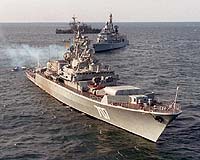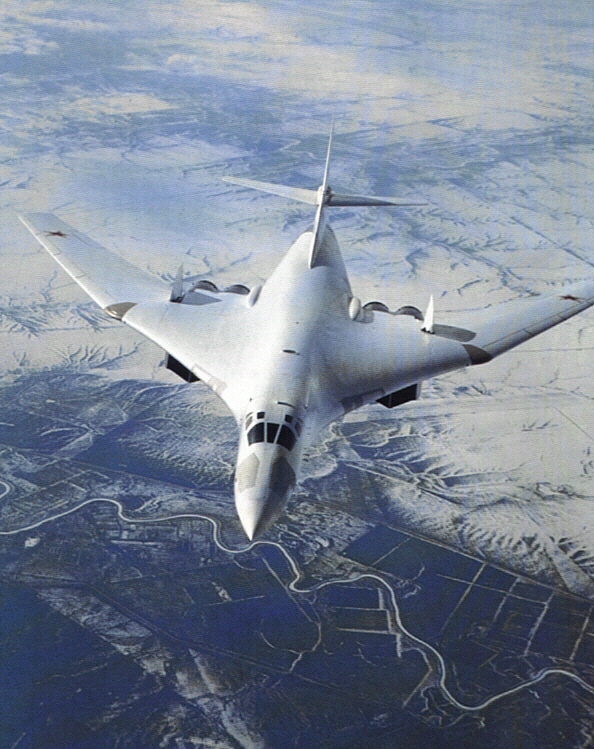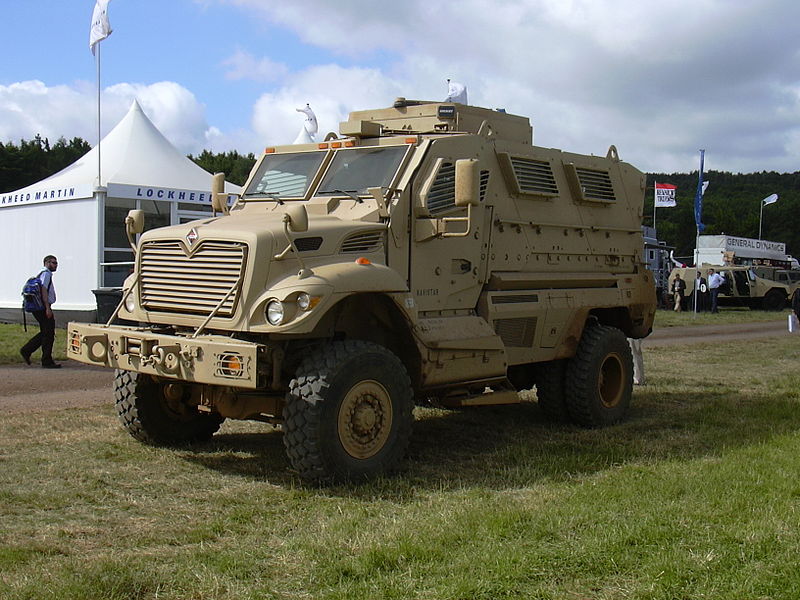Thursday, October 23, 2008
Russia Sends Out The Nuke Bombers For Week Long Exercises
Russia Sends Out The Nuke Bombers For Week Long Exercises
(NSI News Source Info) Washington - October 23, 2008: Russia's front-line long-range strategic nuclear bombers have carried out a new series of major weeklong exercises, the Russian air force announced last week.
The operations were carried out within the framework of the Stability-2008 strategic command and staff exercises, from Oct. 6-12 under the command of three-star Col. Gen. Alexander Zelin, the commander in chief of the Russian air force. More than 30 bombers were involved, the RIA Novosti news agency reported.
"A total of 40 sorties have been flown with an aggregate of 300 flying hours clocked," according to Maj. Gen. Pavel Androsov, commander of Russian Long-Range Aviation Forces.
The Stability-2008 operations have been carried out all over the huge Russian federation and the former Soviet republic of Belarus to improve the strategic deployment of the Russian armed forces, including the nuclear triad of land-, submarine- and air-launched nuclear missiles. They began on Sept. 22 and were scheduled to conclude Tuesday, Oct. 21, the report said.
The Oct. 6-12 component of the exercise involved Tupolev Tu-160 White Swans (NATO designation Blackjack) and Tupolev Tu-95MS (NATO designation Bear-H). The aircraft operated carrying full combat payloads and, as planned, fired all of their standard-issue X-55 air-launched cruise missiles -- ALCMs. It was the first time cruise missiles had been live-fired from Russian bombers in major tactical exercises in nearly a quarter-century since 1984, during the last major flare-up of the Cold War between the United States and the Soviet Union.
Tupolev Tu-95MS Bears have a payload of six KH-55 (NATO designation AS-15 Kent) long-range cruise missiles, and the gigantic Tu-160s, with their 99,000-pound payload -- twice that of a U.S. B-2 Stealth bomber -- has a payload of 12 KH-55s, RIA Novosti said.
The Russian air force described the scale of the Oct. 6-Oct. 12 operations as unprecedented, RIA Novosti said. The maneuvers also included Tupolev Tu-22M3 Backfire strategic bombers, air superiority fighters, interceptors and aerial tankers, the report said.
RIA Novosti said the Russian air force was believed to currently be operating 16 Tu-160 Blackjack bombers, 40 Tu-95MS Bear bombers and 141 Tu-22M3 Backfire bombers.
In an earlier RIA Novosti report previously cited in these columns, the former Russian air force commander, four-star General of the Army Pyotr Deynekin said Tu-95 Bear bombers had carried out live-firing of all their cruise missiles only on one previous occasion in all their operational service, in 1984.
"Tu-160 bombers have never done this, because it is very expensive," the general said.
Aerojet wins Kill vehicle DACS contractAerojet, a GenCorp company, announced Oct. 13 it had won a contract for the Kill Vehicle -- KV -- Commonality Pathfinder Divert and Attitude Control System -- DACS -- from the U.S. Missile Defense Agency.
The Sacramento, Calif.-based Aerojet said its propulsion system could direct the KV through the firing of individual thrusters as the KV was heading to hit a ballistic missile or its warhead. The company will now construct and perform integration work on a test KV DACS. Then the DACS system and the reliability of its technical components, what the company calls "component technical maturity," will be checked out in a static hot-fire test before it is incorporated into a KV configuration and simulated flight test.
"Aerojet is proud to offer more than 20 years of hardware development, qualification and production under MDA programs," said Aerojet's Manager of Programs Warren Yasuhara. "Our experience results in high mission assurance and a low-cost approach for future applications."
Boeing wins new deal for more ATL testsBoeing announced Oct. 14 it had won a new $30 million U.S. Air Force contract to carry on with tests of the Advanced Tactical Laser.
The company said in a statement that it had signed a new Extended User Evaluation contract with the Air Force's Air Armament Center on Sept. 30 "to operate and maintain the ATL system, enabling the Air Force and other potential users to assess ATL's capabilities."
Boeing's ATL is a Lockheed Martin C-130H Hercules military transport aircraft that has been adapted to carry a high-energy chemical laser and beam control system. The ATL is to be subjected to a new program of ground and flight tests during the EUE process. Boeing described its new EUE contract as "a follow on" to the Advanced Concept Technology Demonstration contract that was awarded previously to Boeing to create and perform integration work on the ATL system.
"The Extended User Evaluation will expand the envelope of the Advanced Tactical Laser and further demonstrate how this ultra-precision engagement capability can significantly reduce collateral damage," said Scott Fancher, vice president and general manager of Boeing Missile Defense Systems. "ATL has the potential to perform a wide range of important missions for the war fighter."
"The Extended User Evaluation will give the war fighter the opportunity to conduct hands-on operation of ATL and determine how this transformational laser-gunship technology can be integrated into the battlefield," said Gary Fitzmire, vice president and program director of Boeing Directed Energy Systems.
The ATL system is designed to hit its designated targets with pinpoint accuracy, vastly reducing the dangers of collateral damage, especially in heavily populated urban environments.
Boeing's ATL industry team has L-3 Communications/Brashear, the company that constructed the laser turret, and HYTEC Inc., the firm that constructed some of the structural elements of the weapon system.
Russia launches 31-year-old Stiletto missile
 Russia launches 31-year-old Stiletto missile
(NSI News Source Info) Moscow - October 23, 2008: Russia on Wednesday test fired a 31-year-old intercontinental ballistic missile known by its NATO codename Stiletto from the Baikonur space base in Kazakhstan, Russian news agencies reported.
"The launch was carried out in accordance with a programme to prolong the lifetime of the RS-18 strategic missiles," Alexander Vovk, a spokesman for strategic missile forces, was quoted as saying by Interfax.
"The missile launched on Wednesday was 31 years old," Vovk said, without specifying the target for the test. Targets for Russian missile tests are often in the country's Far East Kamchatka peninsula.
The first RS-18 missile, which NATO calls the SS-19 Stiletto, came into service in 1975. It is 24 metres (79 feet) long, with a diameter of 2.5 metres, and can be equipped with up to six warheads.
Russia has stepped up test firing of missiles in recent months while also ratcheting up its rhetoric against US plans to build missile defence installations in Poland and the Czech Republic.
Moscow says the planned US missile shield threatens its national security, while Washington says it will protect against a possible attack from "rogue states" such as Iran.
Baikonur is Russia's main space base and is mostly used for civilian space launches, including flights to the International Space Station.
Built in Soviet times, the base is now in the ex-Soviet republic of Kazakhstan and is leased by the Russian government.
Russia launches 31-year-old Stiletto missile
(NSI News Source Info) Moscow - October 23, 2008: Russia on Wednesday test fired a 31-year-old intercontinental ballistic missile known by its NATO codename Stiletto from the Baikonur space base in Kazakhstan, Russian news agencies reported.
"The launch was carried out in accordance with a programme to prolong the lifetime of the RS-18 strategic missiles," Alexander Vovk, a spokesman for strategic missile forces, was quoted as saying by Interfax.
"The missile launched on Wednesday was 31 years old," Vovk said, without specifying the target for the test. Targets for Russian missile tests are often in the country's Far East Kamchatka peninsula.
The first RS-18 missile, which NATO calls the SS-19 Stiletto, came into service in 1975. It is 24 metres (79 feet) long, with a diameter of 2.5 metres, and can be equipped with up to six warheads.
Russia has stepped up test firing of missiles in recent months while also ratcheting up its rhetoric against US plans to build missile defence installations in Poland and the Czech Republic.
Moscow says the planned US missile shield threatens its national security, while Washington says it will protect against a possible attack from "rogue states" such as Iran.
Baikonur is Russia's main space base and is mostly used for civilian space launches, including flights to the International Space Station.
Built in Soviet times, the base is now in the ex-Soviet republic of Kazakhstan and is leased by the Russian government.
Russia To Build Second Missile Frigate For Indian Navy By March
 Russia To Build Second Missile Frigate For Indian Navy By March
(NSI News Source Info) Kaliningrad, Russia - October 23, 2008: A Russian shipyard said on Thursday it would complete the construction of the second of three missile frigates for the Indian Navy by March 2009.
The Yantar shipyard in Russia's Baltic exclave of Kaliningrad said the second Project 11356 frigate was more than 50% complete.
India and Russia signed a $1.6 billion contract for the construction of an additional three Project 11356 Krivak IV-class guided missile frigates for the Indian Navy in July, 2006.
Russia previously built three Krivak-class frigates - INS Talwar, INS Trishul and INS Tabar - for India, and delivered them all in late 2004.
The final vessel is due to be delivered to India by 2011-12. All of the frigates will be armed with the BrahMos supersonic anti-ship cruise missile system instead of the Club-N/3M54TE missile system, which was installed on previous frigates.
The Krivak-class frigate has deadweight of 4,000 metric tons and a speed of 30 knots, and is capable of accomplishing a wide range of maritime missions, primarily hunting down and destroying large surface ships and submarines.
Russia To Build Second Missile Frigate For Indian Navy By March
(NSI News Source Info) Kaliningrad, Russia - October 23, 2008: A Russian shipyard said on Thursday it would complete the construction of the second of three missile frigates for the Indian Navy by March 2009.
The Yantar shipyard in Russia's Baltic exclave of Kaliningrad said the second Project 11356 frigate was more than 50% complete.
India and Russia signed a $1.6 billion contract for the construction of an additional three Project 11356 Krivak IV-class guided missile frigates for the Indian Navy in July, 2006.
Russia previously built three Krivak-class frigates - INS Talwar, INS Trishul and INS Tabar - for India, and delivered them all in late 2004.
The final vessel is due to be delivered to India by 2011-12. All of the frigates will be armed with the BrahMos supersonic anti-ship cruise missile system instead of the Club-N/3M54TE missile system, which was installed on previous frigates.
The Krivak-class frigate has deadweight of 4,000 metric tons and a speed of 30 knots, and is capable of accomplishing a wide range of maritime missions, primarily hunting down and destroying large surface ships and submarines.
Smaller, lighter MRAPs headed to Afghanistan
Smaller, lighter MRAPs headed to Afghanistan
(NSI News Source Info) Thursday October 23, 2008: The Pentagon is speeding deliveries to Afghanistan of armored vehicles designed to protect troops against roadside bomb attacks — smaller, lighter versions of what are known as MRAPs.
The MRAPs — the acronym stands for mine-resistant, ambush-protected — are being sent as U.S. forces report an increase in the number of roadside bombs being used by insurgents against coalition forces in Afghanistan.
“There is a desire on the part of commanders there to get more MRAPs into theater,” said Defense Department spokesman Geoff Morrell at a Pentagon news conference.
Morrell did not know how many more will be delivered, and the U.S. Transportation Command declined to discuss the numbers involved. But Morrell noted that an additional 822 new, lighter MRAPs being built by Navistar Defense will be fielded beginning in November. Commanders say Afghanistan’s rugged terrain demands off-road mobility, which presents a challenge for the older, heavier MRAP models.
There are now 1,122 MRAPs deployed in Afghanistan, Morrell said. He said he knew of no plans to transfer to Afghanistan any of the 9,341 MRAPs now in Iraq, where U.S. forces are slowing drawing down in size. But officials are looking at whether any MRAPs that have been offloaded in Kuwait awaiting delivery to Iraq can be diverted to Afghanistan, he said.
Since Afghanistan is landlocked and no “appropriately secure” route exists for overland delivery of the large vehicles, MRAPs must be airlifted into the country, said Army Lt. Col. Frederick Rice of TransCom. Some will be flown directly from the U.S., but others will be transported forward by ship and then transferred to cargo aircraft for delivery to Afghanistan, he said.
The Pentagon still plans to acquire a total of 15,800 MRAPs, Morrell said. So far, about 10,500 have been transported to the U.S. Central Command area of operations, according to Rice.
AF Officials Agree to Ship 18 Cargo Planes to Afghanistan
AF Officials Agree to Ship 18 Cargo Planes to Afghanistan
(NSI News Source Info) ROBINS AIR FORCE BASE, Ga. - October 23, 2008: The deal is done for the Air Force officials to ship 18 G-222 cargo planes to the Afghan National Air Corps.
Officials signed the $287 million contract at Robins AFB Sept. 29. The Italian-built planes are being purchased from Alenia North America and will be refurbished, with 16 to serve as medium tactical support transport aircraft and two others will get VIP configurations to serve as aircraft for the president of Afghanistan. The contract calls for shipment to begin in September 2009 with deliveries to continue through 2011. Although Robins won't be doing any work on the planes, the contract was signed here because the program office is here, said Debbie Mashburn, the security assistance program manager. The planes are known in the Air Force as the C-27A Spartan, though the Air Force no longer uses the planes. The planes are capable of delivering 10 tons of cargo, transporting vehicles and providing medical evacuation for 36 patients, said Ms. Mashburn. She said the Air Force has determined that the planes are vital to helping the Afghanistan government provide humanitarian assistance, medical evacuation and logistic support throughout the country. The G-222, she said, has a reputation as a rugged aircraft that is well suited for take off and landing from unprepared and short landing strips.
First Flight of Typhoon In Royal Saudi Air Force Livery
First Flight of Typhoon In Royal Saudi Air Force Livery
(NSI News Source Info) October 23, 2008: BAE Systems has flown the first of 72 Eurofighter Typhoons for Saudi Arabia, seen above at the company’s Warton airfield in North West England. (BAE Systems photo)A Eurofighter Typhoon fighter aircraft in the full two-tone grey livery of the Royal Saudi Air Force (RSAF) has flown for the first time today at BAE Systems’ Warton Aerodrome in Lancashire, North West England. This milestone marks the start of an initial test flight programme for RSAF Eurofighter Typhoon aircraft being assembled at Warton.
In December 2005, the Saudi Arabian and UK Governments announced the signing of an Understanding Document that aimed to establish a greater partnership in modernising the Saudi Armed Forces. This paved the way for the acquisition of 72 Eurofighter Typhoon aircraft, and the transfer of technology, investment and training, confirmed on 17 September 2007. BAE Systems, which has had a presence in Saudi Arabia since 1973, is one of the largest companies in the industrial sector and currently employs 4,700 people. Directly linked to Saudi Arabia’s acquisition of Eurofighter Typhoon, the Company is making good progress on agreeing a partnered support approach. This will offer significant levels of opportunity for Saudi industry, specifically through the development of an engineering and manufacturing footprint and a Centre for Arab Excellence. BE Systems is the premier global defence and aerospace company delivering a full range of products and services for air, land and naval forces, as well as advanced electronics, information technology solutions and customer support services. With approximately 100,000 employees worldwide, BAE Systems' sales exceeded £15.7 billion (US $31.4 billion) in 2007.



